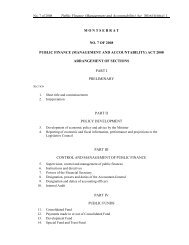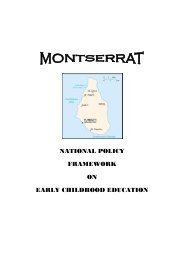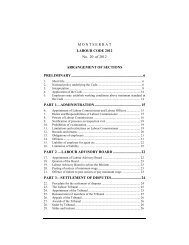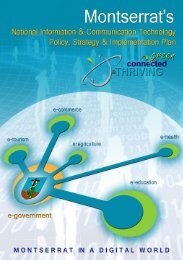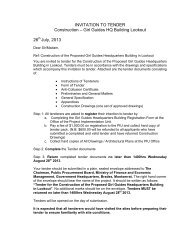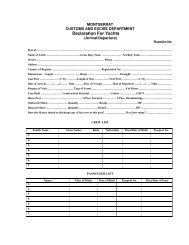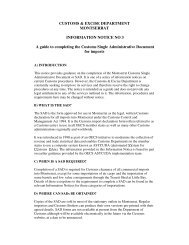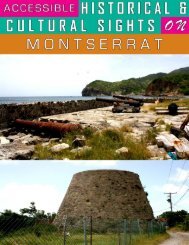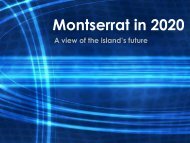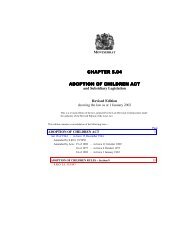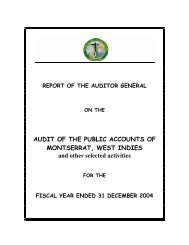Montserrat Survey of Living Conditions (MSLC) Executive Summary
Montserrat Survey of Living Conditions (MSLC) Executive Summary
Montserrat Survey of Living Conditions (MSLC) Executive Summary
Create successful ePaper yourself
Turn your PDF publications into a flip-book with our unique Google optimized e-Paper software.
<strong>Montserrat</strong> <strong>Survey</strong> <strong>of</strong> <strong>Living</strong> <strong>Conditions</strong><strong>Executive</strong> <strong>Summary</strong>on a review <strong>of</strong> their Sustainable Development Plan 2008-2012 (SDP). This review provides an idealmechanism for some <strong>of</strong> the Poverty Action Programme recommendations to be rapidly incorporated intothe new version <strong>of</strong> the MSDP.2 Background and Context (Chapter 2)2.1 Geographic and Historical Setting<strong>Montserrat</strong> is one <strong>of</strong> the Leeward Islands in the Eastern Caribbean, lying 43km south-west <strong>of</strong> Antigua and64km north-west <strong>of</strong> Guadeloupe. It is approximately 102 sq km (16 km long and 11 km wide) andgrowing slowly due to volcanic deposits on the southeast coast <strong>of</strong> the island. The topography is entirelyvolcanic and very mountainous, with a rugged coastline with dramatic rock faced cliffs rising from the sea.<strong>Montserrat</strong> was populated by Arawak and Carib people when it was claimed by Christopher Columbus forSpain on his second voyage in 1493. The island fell under English control in 1632 when a group <strong>of</strong> Irishfleeing anti-Roman Catholic sentiment in Saint Kitts and Nevis settled there. The import <strong>of</strong> slaves startedat much the same time and an economy based on sugar, rum, arrowroot and Sea Island cotton wasestablished during the seventeenth and eighteenth centuries. Slavery was abolished in 1834 following thegeneral emancipation <strong>of</strong> slaves within the British Empire which occurred in that year.Falling sugar prices during the nineteenth century had an adverse effect on the island's economy and in1869 the British philanthropist Joseph Sturge formed the <strong>Montserrat</strong> Company to buy sugar estates thatwere no longer economically viable. The company planted limes and started production <strong>of</strong> the island'sfamous lime juice, set up a school, and sold parcels <strong>of</strong> land to the inhabitants <strong>of</strong> the island, with the resultthat much <strong>of</strong> <strong>Montserrat</strong> came to be owned by smallholders.From 1871 to 1958 <strong>Montserrat</strong> was administered as part <strong>of</strong> the Federal Colony <strong>of</strong> the Leeward Islands,becoming a province <strong>of</strong> the short-lived West Indies Federation from 1958 to 1962. It is currently one <strong>of</strong>Britain’s remaining overseas territories with the Queen as head <strong>of</strong> state, a governor appointed by theQueen and a democratically elected Chief Minister.The last years <strong>of</strong> the 20th century, however, brought two events which devastated the island. In September1989, Hurricane Hugo struck the island with full force, damaging over 90 percent <strong>of</strong> the buildings andvirtually wiping out the then burgeoning tourist trade. Within a few years, however, the island had largelyrecovered - only to be struck again by the major eruptions <strong>of</strong> the Soufriere Hills volcano in 1995 and 1997.Two and half years <strong>of</strong> intense volcanic activity saw the southern, most populated and most fertile part <strong>of</strong>the island, evacuated and declared unsafe. Plymouth, the capital and the territory’s industrial, commercial,and government centre, was almost totally destroyed along with the island’s airport and hospital; manypeople lost their houses and had to be evacuated. Over half the population left and a steep economicdecline followed. Reconstruction efforts started in earnest in the early 2000s and the northern, habitablepart <strong>of</strong> the island now has government <strong>of</strong>fices, schools, a hospital and an airport along with new housingestates and much improved roads. The island however remains largely dependent on assistance from theBritish Government.<strong>Montserrat</strong> Country Poverty Assessment, Final ReportHalcrow Group Limited, July 2012.ES2




